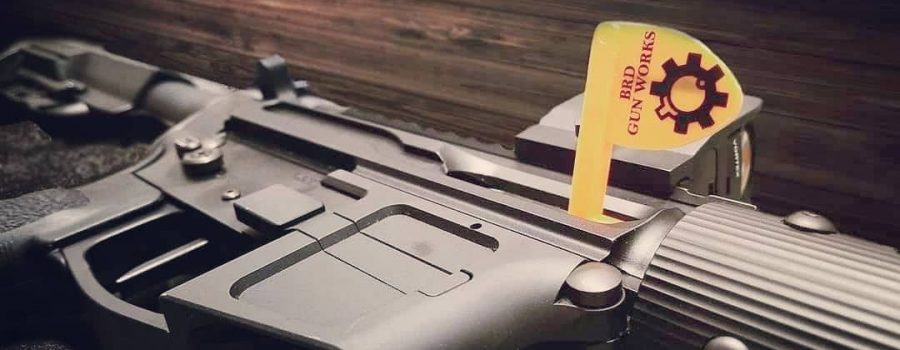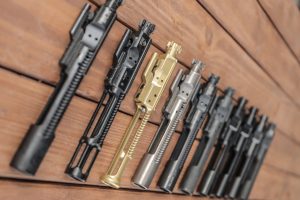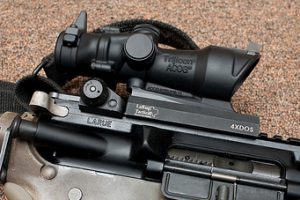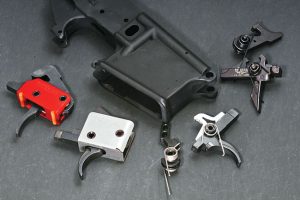With the current state of ammunition availability and costs, especially in the popular rifle calibers such as 5.56 NATO and 300Blk, many individuals are not practicing or training as much as they once did.
With the civil disturbances and multiple cities in the U.S. defunding police forces and having long stretches of violent lawlessness, many people have awoken to the fact that they are responsible for their own protection, or that of their families. The market has been overwhelmed by first time gun owners purchasing guns, and in my personal experiences a lot of them are AR platform or similar types of long guns. Looking again at my experiences, as well as a trend that has been noted by other dealers, the majority of my clients were in their 50’s or 60’s.
Many Americans who are continuing their training and their practicing will most likely be spending more time doing so at the indoor ranges. Unfortunately, many rifles are poorly suited for such close quarters. The blast of a 5.56 is much less pleasant when it’s amplified in a booth, let alone that of even larger calibers or AR’s with muzzle brakes and comps. And some indoor ranges do not allow centerfire rifles such as the AR, but will allow AR PCC’s.
All of the above factors, in addition to others that have not been covered, all contribute to why Pistol Caliber Carbines (PCC’s) are worth looking at and possibly jumping into the PCC world.
These blasters have countless compelling benefits, but I’ve found most PCC owners are convinced for 6 main reasons:
- Historicity
- Competition
- Shootability
- Cheaper ammunition
- Controls are similar to their bigger brothers for training and practice purposes
- The incredible fun factor
Let’s define what exactly is a PCC, and how does it differentiate from other carbines?
What Is A PCC?
The naming says it all. A PCC is a Pistol Caliber Carbine. Pistol Caliber Carbines (or PCC’s) are rifles and carbines chambered in pistol calibers: 9mm, .45ACP, and .40 S&W are common but there are others such as the 10mm and .357 Sig.
Some of the most popular PCC’s are 9mm AR’s, often called AR9’s. In addition, many manufacturers make carbine-versions of popular sub-machine guns, including the HK MP5 or SP5, or the CZ Scorpion Evo.
PCC’s combine low-recoil pistol cartridges with a full-size rifle body, and therefore PCC’s are inherently easy to shoot and cheap to feed. In normal times that is. But, it is still cheaper to feed than those in 5.56, 300Blk, 6.5 Grendel, 450 Bushmaster, .308 Win, etc. These attributes make it an ideal candidate for new shooters to the platform, junior shooters, female shooters that may not be able to support the weight of a rifle caliber AR-15, or for shooters that may have medical conditions that make holding and/or operating the bigger guns problematic.
When you’re not shooting beyond 200 yards (yes, in some competitions it is not unrealistic to engage targets at ranges close to 200yds at time times with a PCC), PCC’s offer all the training and fun of their full-size counterpart in a more compact, cost-effective package. While they won’t have the same kick, a PCC will keep you smiling every time you ring that steel gong, knock down a few steel plates, or consistently shoot out the center of that B8 target.
Of course, there are some other important benefits too, entirely unique to the PCC family…
PCC History
Sub-Machine Guns (or SMG’s) have played an important part of every nation’s military since the days of World War I. Many Americans have a deep affection for the beauty of a well-crafted SMG, but few have the money or time to take home the real-deal. This is where the clone guns have a great appeal, and PCC’s are no different.
A Pistol Caliber Carbine takes the beauty of SMG’s and brings it into a civilian package that can readily be converted from a rifle or “pistol,” to an SBR. Whether you’re looking for a new-age marvel like the Vector or retro favorite like the Colt 9mm SMG, you’ll find a PCC to recreate that unique slice of history.
In some cases, a PCC is your only real option. HK is known for their iconic SMGs, such as the UMP and MP5. In the UMP’s case, the only available option in the US is through their USC carbine. The MP5 comes in a full pistol version, but if you want to use a stock, the closest non-NFA option is Zenith’s MP5 carbine. Although, HK has recently released the hot commodity that is the SP5.
Competition PCC
Pistol Caliber Carbines are also an increasingly popular division for competitors in both USPSA and IDPA. Both of which allow for a variety of customization and tuning options, and still be within the respective rules of each sport.
But it goes beyond that now. PCC’s are now one of the more popular divisions within Steel Challenge matches, with options for both optics and irons. The United States Practical Shooting Association is supporting its own PCC division, which functions similarly to the optics division in Steel Challenge. IDPA started their own PCC division a year later in 2017, available in Tier 1 to Tier 5 matches.

Various 3-Gun competitions have also opened for PCC use, though the exact rules will largely vary from match to match. Given the growing popularity for PCCs, many local matches are eagerly accepting PCC use.
There are now PCC only matches too. PCC’s even have their own “Nationals”.
PCC is one of the best ways for newer enthusiasts to get started into the world of competitive shooting. With affordable ammunition and low recoil, new competitors can learn the basics and build up their essential skillset. As an avid competitor in IDPA and USPSA PCC divisions, I will also add that it is a lot of fun to be running and gunning the field courses with a high capacity, low recoiling, red dot mounted, “cheater” boom stick. It doesn’t matter what skill level of shooter you are, PCC is a good time.
Fun Factor
The largest reason people are gravitating to Pistol Caliber Carbines is simple……. PCC’s are really, really fun. They are a great way to introduce younger shooters to the shooting sports.
Getting behind a PCC and popping some steel targets is very reminiscent of shooting pop cans with a BB gun. The noise level and blast intimidation that some experience with the full-size counter parts is very slim. You really come to appreciate how mellow a 9mm sounds coming from a full-length barrel. It’s easy to relax and plink away at paper, steel, reactive targets, whatever trips your trigger, and you’ll come away from it with much lower ammo bills too.
The balance and weight of a PCC can be much easier for some to manage. Especially when you begin to look at the intermediate and shorter length barrels. These will bring the center of gravity back towards the rear of the gun. This can aid in a faster handling PCC, and one that feels lighter than what it is. All of this makes the overall shootability of a PCC much easier for some individuals.
If you’ve got one of those historic firearms, you’ll also get a lot of attention from other folks at the range. Very few people have spent much time behind an SMG, so you’ll find people drooling to try many of the most iconic PCC’s. But the same can be said of tricked out competition PCC’s or Insta cool guns. Many people see these in FB posts, on Instagram, or in other social media arenas but some rarely get to see one in person. So if you have one at your local range don’t be surprised if inquiring minds want to know. This frequently.
When you become sufficient with your PCC and began to burn down steel plates, quickly and accurately blow the center zone out of paper targets, shoot impressive splits with accuracy, etc. don’t be surprised when individuals approach you wanting to know what you’re shooting.
PCC As A Training Aid
A lot of PCC’s have the same or similar controls as their bigger brothers, the AR-15 and LR308 platform. Dependent upon the manufacturer as well as component selection, most PCC’s can even use the same triggers, charging handles, optics or sights, handguards, etc. that you may use on your AR-15. This allows you to create a PCC that replicates or is very similar to your duty or defensive AR, but in a caliber that is much more budget friendly.
When using the PCC as a training aid, the controls layout of most PCC’s will translate over to your larger AR. This is a positive in learning and retaining AR platform skills. You may even be able to duplicate or come close to the same trigger pull.
A couple of areas that you will most likely be deficient in are the weight as well as the recoil pulse characteristics of the PCC. Most PCC’s when similarly equipped will be lighter than their larger counterparts, and this can also effect the balance of the gun. Secondly, most all PCC’s are a blowback operation. With a couple of exceptions. Blowback operation tends to provide for a more abrupt recoil impulse due to the fact that there is no bolt to physically unlock from a barrel extension which effectively delays unlocking and reduces chamber pressure. Therefore, blowback PCC’s rely upon mass in both the “bolt” assembly and the buffer combined with the buffer spring rate to delay the opening of the bolt which causes a reduction in chamber pressures. But this is nowhere near as efficient as the bolt unlocking in an AR-15 or LR308 platform.
In my opinion, as well as that of many others, the above two characteristics do not override the advantages that the PCC guns offer.
I stated that there are a couple of exceptions to the blowback design. One is the CMMG Radial Delay design which uses a partial locking bolt, and then the design that Sig Sauer uses. Both of these designs are well worth checking out.
PCC As A Defensive Tool
Due to the weight, the compactness that PCC’s can have, their stability and ease of shootability, magazine capacity, rate and ease of fire, as well as other components all combine to make for a viable and effective defensive gun.
Again when we look at junior shooters, newer shooters, female and even male shooters, and those with certain medical conditions, a PCC can be an easier tool to use than a handgun or larger frame AR.

Myself, as well as other instructors have found that it can be easier to teach a new(er) shooter to shoot a rifle more proficiently than a handgun, and to get better hits. Especially at distance. Shooting a handgun proficiently is a hard task to master. There are many components that make the task more difficult. Some of these are only two points of contact with handgun (grip strength and forearm can generally have an effect on this as well), the shorter sight radius of iron sights which requires a front sight focus for accurate hits, trigger pulls can play into this (DA only, DA/SA, etc.), a stable and balanced stance, and a few other things. Rifles and PCC’s on the other hand do not have some of these concerns to contend with. When you combine these factors with the four points of contact with a rifle/PCC and a much more manageable recoil, and it just makes for an easier platform to learn and shoot.
Let’s face it. The muzzle blast and concussion of 5.56 or larger calibers when indoors or within confined spaces really sucks. If you’ve ever been in a shoot house, in vehicles, or in other confined areas when these are touched off then you know what I am talking about. You haven’t done those things you say/ Go to an indoor range and get a stall next to the wall. Touch a few rounds off. Then you’ll have an idea. Better yet, if you have some friends with you, all of you touch off rounds at the same time. Yep, it kinda sucks. This is another advantage of the PCC’s. Dependent upon the caliber of PCC (9mm is the most common) you will find that the muzzle blast and concussion is far less than that of its bigger brothers. This is an advantage when looking at weapon selection for home defense.
But I run a suppressor you say! Those are good options for confined areas. They lessen noise while most will also reduce muzzle flash signature. The latter being the real advantage of a suppressor. This negates the concerns of 5.56 and larger calibers with noise and flash in confined areas, but it does not address the issue of weight and ease of handling and shootability that gives the PCC’s their advantages for some shooters.
I’m not knocking the larger caliber counterparts for home defense use. There are many advantages. What I am saying is that for some individuals a PCC is a very viable defensive tool option.
How To Get Started
Depending on what kind of PCC you want, prices can vary from just a couple hundred to several thousands. If you’re trying to recreate a semi-automatic version of some rare SMG, expect to make a large investment of both time and money. If you’re looking for a competition gun, the same can be said. A good competition gun that is accurate and reliable will require a bit of monetary investment. As for a defensive style PCC, the same that applies to the AR-15 platform also applies to the PCC world. Use of quality and proven parts. PCC’s can be finicky with subpar parts. I see this frequently with budget friendly factory rifles as well as home builds. But if you’re just looking to plink around and have some fun with a reliable PCC, it can be done at a reasonable cost.
How To Feed It
The first choice that you have to make when selecting a PCC or if you’re planning on assembling one is, what magazine platform are you going to select? Currently the big three platforms are the Glock magazine, Colt magazine, or the MP5 magazine. With Ruger’s PCC it uses Ruger specific magazines, but the ones I’ve seen also include a Glock magwell assembly so that you can use Glock magazines.
In my experiences with the PCC platform, the Glock magazines have proven to be the most dependable when it comes to feeding a PCC. Another advantage that Glock has is the plethora of 9mm magazines that can be used in most PCC’s. This allows for 10 round to 30+ round magazine capacities. And, Glock magazines can be found just about anywhere at reasonable prices. A bonus is that there is a healthy aftermarket for proven Glock magazine extensions that will allow you to really boost the capacity for competition or self-defense.
While most SMG aficionados have a thing for the HK MP5, and the MP5 magazines are a classic, they do have a couple of downfalls in the PCC guns. First, they do not allow for last round bolt hold open function. So if it is important to you that the bolt locks back on an empty magazine, the MP5 magazine platform is not for you. Secondly, they are expensive to purchase in comparison to the Glock and Colt mags. But the MP5 magazines do provide for an exceptional look in the PCC guns.
Last Round Bolt Hold Open (Lrbho)
You will have to decide if you want the bolt to lock back on an empty gun. For most PCC competitions this is a function that you will not want. An exception to this is if you’re shooting in IDPA sanctioned matches. If it is just a fun range toy for you, then you may also not want this feature.
If you’re going to use it as a defensive tool then I would recommend selecting a PCC with LRBHO. A robust and dependable one at that. Some manufactures utilize a bolt catch that closely resembles that found on the AR-15 platform, while others utilize a round stock wire that typically require consistent adjustment for proper operation.
Foxtrot Mike PCC’S
Foxtrot Mike Products is currently one of the middle of the pack leading names in PCC’s, providing good-quality AR-pattern PCC’s at very approachable prices. My competition PCC is built off of a Foxtrot Mike Glock compatible lower receiver. Their lower receivers are one of my favorites due to their Last Round Bolt Hold Open (LRBHO) feature. This locks the bolt back on an empty magazine. Not all PCC receivers have this feature. Their LRBHO function is also very robust and I have had no concerns whatsoever. Their upper receiver groups come in a variety of setups and calibers, including both 9mm and .45ACP. You can also choose between standard rear-charging and a side-charging upper receiver group. A thing to note on their side charger is that the charging handle is located in the front left of the handguard. This is an unusual placement area as most are on the left side of the receiver.
Since the Foxtrot Mike PCC’s feed from Glock mags, many of you will already have compatible magazines. If you don’t have any Glock magazines, no need to worry as they are some of the most affordable pistol mags around.
Frontier Armory
Frontier Armory is one of the bigger names and pioneers in the PCC game. Like Foxtrot Mike, Frontier Armory provides a lot of quality components and guns at very reasonable prices. Frontier Armory does a lot of variance work for other PCC manufacturers, meaning that they make the parts to the specs of another manufacturer and that manufacturer brands it under their own name. At Frontier Armory you will also find components to assemble .40 S&W PCC’s.
Want The Insta Cool And FB Likes?
If you are looking for a PCC with cool and cutting edge looks, there are many manufacturers that can fill your needs. But at a price of course. Such manufacturers are Quarter Circle 10, Gibbz Arms, and Angstadt Arms just to name a few. These three that I mentioned also provide serious quality to their components. While they look cool, they also function. Something that you could use as a defensive tool.
On the flip side of this are manufacturers like Iron City Rifle and Lead Star, both of which are known for their super light, highly machined, super cool looking competition PCC guns. If you are a serious competitor than an offering from one of these companies may be what you’re looking for.
What About Brd Gun Works?
Things are in the works. For the last year three years I’ve been running a PCC in competition. It has been a testing platform for components, allowed for the ability to test different “tuning” aspects of different set-ups, test operational characteristics and reliability of various components, etc. At this time I am looking to offer a couple of competition model PCC’s, but there is no ETA as to when these will become reality.

There has also been work, testing, and continued development of shorter defensive style AR9’s. These have had barrels around the 8” length mark and have provided some impressive ballistics with certain ammunition. An example is a 124g load at about 1400fps. That is on the lower end of .357 Magnum ballistics from a longer barrel revolver. Consideration has been given to PDW style AR’s and is consistently being evaluated.
You can check out some of the guns and uppers here.
Other Offerings
If you’re looking for a PCC other than an AR9, the most popular current-production models include the CZ Scorpion, Kriss Vector, 9mm AK, AND THE Ruger carbine has been rising in popularity. The Scorpion has some of the largest aftermarket options, including magazines from Magpul and others. The Kriss Vector is well-known for its innovative bolt design, making it a popular choice for sci-fi enthusiasts. Finally, the various 9mm AKs from Century and Kalashnikov USA help lend a flair to our PCC lineup.
Once you’ve got a PCC in-hand, you only need a red dot sight and a few boxes of ammo to get you prepped and ready for plinking.
End Story
The Pistol Caliber Carbine market has exploded in recent years and has become a fast-favorite in the firearms community, and it’s easy to see why.
No matter how you want to use a PCC, you’re certain to have a great time, or at least a great conversation piece. Plus, as previously stated, if you want to get someone started in firearms, there’s no better alternative for basic carbine handling.
Find out what the excitement IS about for yourself. Take a dive into the world of PCC’s.
BRD Gun Works~ Performance you can afford when you can’t afford failure



